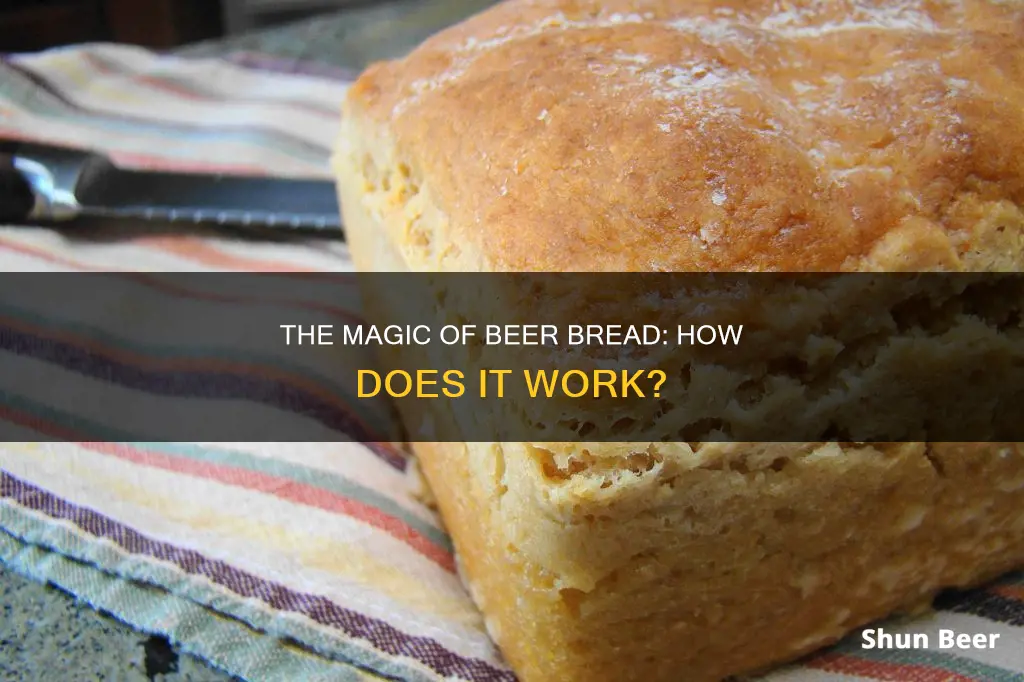
Beer bread is a simple and tasty dish that can be made in a variety of ways. It is a type of bread that includes beer in the dough mixture, and can be made with or without yeast. The beer contributes to the leavening process, resulting in a light and fluffy texture. The type of beer used can also enhance the flavour of the bread, with darker beers producing a more robust taste. Additional ingredients such as cheese, herbs, and butter can be added to create different variations of beer bread, making it a versatile and comforting dish.
What You'll Learn

Leavening agents
There are three main types of leavening agents: biological, chemical, and steam.
Biological Leavening Agents
The main biological leavening agent is yeast. Yeast is a one-celled fungus that activates the fermentation process, converting sugar and starch into carbon dioxide bubbles and alcohol. This is necessary for bread dough to rise. Yeast is also responsible for the process of fermentation, without which there would be no beer, wine, or bread.
There are a few types of baker's yeasts:
- Active dry yeast: a dry, granular yeast that is the most commonly used. It must be activated or "proofed" by dissolving it in warm water, ideally heated to 105ºF.
- Instant dry yeast: a dry, granular yeast that can be mixed directly with your flour and does not require proofing. Use ⅓ to ½ less than active dry yeast.
- Fresh yeast: also called cake yeast, this is most commonly used in professional bakeries. It can be mixed directly into dry ingredients or dissolved in water to more evenly disperse it, but it does not need to be proofed first.
Chemical Leavening Agents
Chemical leavening agents are compounds or mixtures that are added to dough or batter and release gases when they react with moisture or heat. The most common chemical leavening agent is baking soda, which has to be mixed with an appropriate acid to create the chemical reaction needed to make the batter rise.
Baking powder is another chemical leavening agent and is mostly just a pre-made mixture of baking soda with an acid and starches or fillers. These are thought to be easier than creating your own chemical reactions.
Steam
Steam is a leavening agent that is used when water vapour is trapped within dough or batter, causing it to expand and create flaky, delicate layers. This is achieved by heating the dough or batter at a high temperature, causing the water to quickly transform into steam.
A Beginner's Guide to Joining a Beer Crawl
You may want to see also

Yeast
In beer bread, the yeast comes from the beer itself. The beer provides the necessary liquid for the dough and also contributes to the unique flavour of the bread. The yeast in the beer interacts with the sugar in the dough, aiding in the rising process.
However, it is important to note that not all beers contain live yeast. Many mass-market beers have the live yeast filtered out, which can affect the leavening process. In such cases, additional leavening agents, such as baking soda, baking powder, or baker's yeast, may be required to ensure the bread rises adequately.
When selecting a beer for beer bread, it is worth considering the desired flavour profile. Different styles of beer will impart distinct characteristics to the bread. For example, a stout or dark beer will result in a darker bread with a more robust flavour, while a spiced or flavoured beer will impart similar notes to the final product.
Additionally, the alcohol content of the beer can be a factor. While yeast can typically withstand alcohol concentrations of up to 14-18%, higher alcohol levels may inhibit the yeast's activity. Diluting the beer with flour helps to reduce the overall alcohol concentration, ensuring a suitable environment for the yeast to function effectively.
In summary, yeast plays a crucial role in the creation of beer bread, contributing to both the structure and flavour of the final product. By understanding the role of yeast and selecting appropriate beers, bakers can create delicious and successful beer bread.
Chilling Beer Fast: How Do Chiller Sticks Work?
You may want to see also

Flour
Self-rising flour is a popular choice for beer bread as it simplifies the bread-making process. Self-rising flour is a combination of flour, a leavening agent (such as baking powder), and salt. By using self-rising flour, you can skip the step of proofing yeast, as the baking powder acts as the leavening agent. However, it's important to note that self-rising flour has a shorter shelf life, typically around six months, due to the presence of baking powder.
If you prefer to use all-purpose flour, you can create a substitute for self-rising flour by adding a leavening agent and salt. For every cup of all-purpose flour, you will need one teaspoon of fresh baking powder and a quarter teaspoon of salt.
When measuring flour, it's important to sift the flour or use a spoon to lightly scoop it into the measuring cup. Compacting the flour by scooping it directly into the cup can affect the outcome of the bread, making it denser and harder.
The amount of flour used in beer bread recipes can vary, but typically, recipes call for around 3 cups of sifted flour. This can be adjusted based on personal preferences and the desired consistency of the dough.
In summary, the choice of flour and the way it is measured play important roles in the texture and rise of beer bread. Self-rising flour simplifies the process, but all-purpose flour with added leavening agents can also be used to create delicious and fluffy beer bread.
Beer Traps: Effective Snail Control or Urban Myth?
You may want to see also

Sugar
The amount of leavening that occurs during the baking process depends on the type of beer used. Some beers contribute to the leavening process, while others do not. If a beer does not contribute to leavening, the bread will be dense and heavy unless an additional leavening agent is added, such as baking soda, baking powder, baker's yeast, or sugar.
The sugar used in beer bread can come from the beer itself. The sugar content of beers varies, with regular lagers typically containing 10 to 15 grams of carbohydrates per pint, while some "light" beers may have less than 5 grams of carbohydrates per pint. Stouts, porters, and Guinness tend to have a higher carbohydrate content, with upwards of 20 grams of carbohydrates per pint.
In addition to the sugar naturally present in the beer, bakers may add more sugar to the dough to enhance the leavening process and create a lighter, fluffier bread.
Beer Science: Brewing Chemistry and History Podcast
You may want to see also

Butter
Beer bread recipes often require melted butter to be poured into the loaf pan before the batter is added. This creates a crispy, buttery crust. The remaining butter is then poured on top of the batter before baking. This technique ensures that the bread is infused with a buttery flavour and that the crust is browned and crispy.
Some recipes recommend dotting butter on top of the bread, while others suggest mixing the butter into the batter for a softer crust.
In addition to its role in the cooking process, butter is also a popular topping for beer bread. A slice of warm beer bread with a smear of butter is a comforting and indulgent treat.
Crafting Beer Partnerships: Collaborating for the Perfect Brew
You may want to see also
Frequently asked questions
You will need beer, flour, butter, and sugar. You can also add baking powder, salt, and honey.
You can use any type of beer. A stout or dark beer will give a darker bread with a more pronounced flavor. Using a beer that is spiced or has a flavor added will make a bread with a similar flavor but less intense than the beer.
You can use self-rising flour or all-purpose flour.
First, grease a loaf pan and preheat your oven. Next, stir together flour, sugar, and (if using) baking powder. Then, pour in the beer and stir until the flour is incorporated. Finally, spoon the mixture into the pan, bake for 40-60 minutes, and brush with melted butter.







